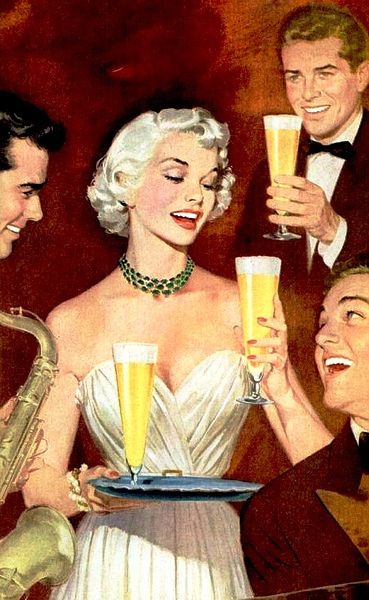How to Taste Everything

How to Taste Everything, For Beginners:
Wine, Beer, and Spirits tasting can be intimidating. It can seem like another world that speaks a different language, and honestly, it kind of is. I’m looking forward to sharing my knowledge about styles, regions, and products that I’ve tried and loved here on CASSIDYALEXA, but first I wanted to share the tasting process with all of you (plus a couple of extra steps) so you can grow your knowledge and passion just like I did. These steps will hopefully help you start your own wonderful journey of flavours, so let’s talk about tasting!
Step 1, Relax:
Treat this article as a list of guidelines and suggestions, and trust yourself to interpret the information and flavours you come across. The reason we taste things is first and foremost to enjoy them, so if you’re loving that Riesling but can’t decide if it tastes more like apples or pears, let it go and just focus on enjoying yourself. The rest comes easier with practice, just like everything else. Crafty producers love to throw curveballs at seasoned consumers, so don’t worry if you come across a product that flies in the face of these guidelines. That’s the fun of innovation! If it defies categorization or if you aren’t getting a bunch of flavours out of a particular beverage, that doesn’t mean you’re doing a bad job or picked a bad scotch. There are lot of reasons we might not get a lot out of a tasting on a particular day, and the important part is to keep trying and enjoying new things in ways that enhance our lives.

Read:
Read the bottle! Producers put varying amounts of information on their labels, but you’re almost always going to be able to get the region of origin and alcohol percentage, and usually the style as well. When you’re done reading, hit Google. Go to the producer’s website. Look up the region the product was made in. For many European products, the region is the same as the style, so your research can really tell you a story. There’s a slew of information out there about the wine grape, scotch region, or beer style you’re about to drink and I can only focus on one at a time, so get in there! For a lot of products, you can also usually find reviews or tasting notes by other people, which can be helpful to read when you’re just starting out. I also highly recommend looking up lists of tasting descriptors for your beer, wine, or spirit, and keeping them handy while you taste. The longer you do this, the more these words will stick in your head, but a tasting vocabulary doesn’t come out of nowhere, and you can make your descriptors more specific and personalized as you go along.
Pour and Look:
In the glass, wine, beer, and spirts show taste indicators before they hit your taste buds, so don’t put your rum in a flask, as roguishly charming as it may seem, use a glass instead. The colour, viscosity, and opacity of a beverage can usually give you clues about what your first sip is going to be like. Alcohol content can be an indicator of body; lower-alcohol products are usually more delicate than higher-alcohol products. Opacity, how hazy the beverage is, is another indicator of body. A dark purple wine or an inky black beer are going to be more full-bodied than a bright clear red wine or a golden light lager. Colours can also be indicators of specific flavor profiles. In beer, a lighter colour might mean soda cracker or bread notes. Amber colours in beer and sprits can mean caramel, or maple, or spice, and brown to black colours belie cocoa, coffee, and smokiness. Basically, the more intense it looks, the more intense it probably is.
Smell:
Now it’s time to get your nose in there! Get that list of descriptors out and start smelling! Start by just sniffing without really doing anything with the glass. A lot of beverages, particularly spirits, don’t really need to be swirled or otherwise agitated to be very aromatic. Just put your nose down there and smell. If you aren’t getting a strong aroma, then its time to swirl. A lot of people already know about swirling wine and spirits, but did you know you can also certain types of beer? If you’re drinking Barleywine, Imperial Stout, Sour Ales or any beer that’s seen the inside of a barrel, pour it in a snifter and swirl away! Head and carbonation deliver scent in beer, but styles with lower carbonation may need a little extra help leaping out of the glass. You also don’t really need to swirl your Champagne for the same reason. Keep those bubbles alive! When you’re tasting spirits, take particular care to inhale slowly and use one nostril at a time, tilting your head to keep the other one out of the glass. Your sinuses will thank you. While you smell, take a look at your descriptors. Does your Cabernet smell like juicy cherries, or smoky chocolate? Does your Farmhouse Ale smell like an apple cobbler or an actual farmhouse? Gin will always smell like juniper, but the smell of the other botanicals will change from brand to brand, and producers usually list their dominant ingredients, making it a good place to start for the novice spirit noser. You don’t need to be too dear about this or spend too long, because we all want to get to…

Taste!
You can smell and taste at the same time. On this step, you’re basically doing the same thing you did while you were smelling, but with your mouth. Get your descriptors, take a sip, swoosh it around a bit, even spirits if you can manage (it took me a while to be able to do this), and start looking at your descriptors. Things usually taste like they smell, so since you’ve already done that, you’ll have some idea of what to say about the taste. Think about how full the beverage feels when you drink it. Is it thin like water or thick like full fat milk? That’s body. Is it acidic and zippy, or round and ripe? Bitter or Roasty? Sweet or dry? Do the flavors unfold one after another or all at once? Does your mouth feel syrupy, puckered, or dry after you swallow? How long do you taste your sip after you swallowed it? That’s what finish is, and a long finish in wine is when you can still taste it 15-20 seconds after you’ve swallowed. Lists of descriptors include fruits, flowers, desserts, breads, pretty much any food you can think of can be used as a tasting note. If that seems like a lot to think about at once, it is. When you’re just starting out, try to just focus on the body (how intense it is), and try to come up with a few specific notes, like cherries, or multigrain bread, or salted caramel. This part is the one that can frustrate people a lot when they aren’t getting it, so if you’re having trouble, remember what I said above and relax! Enjoy your drink for a few minutes and let your mind wander and things will start to pop into it. We drink to relax, treat ourselves, and experience the expression of a place through it’s flavors, and focussed tastings are meant to enhance that, so if it isn’t, always remember to slow down and just enjoy!
I hope you all have a better idea of how to taste Wine, Beer, and Spirits, and I look forward to helping you find delicious flavours in future columns!